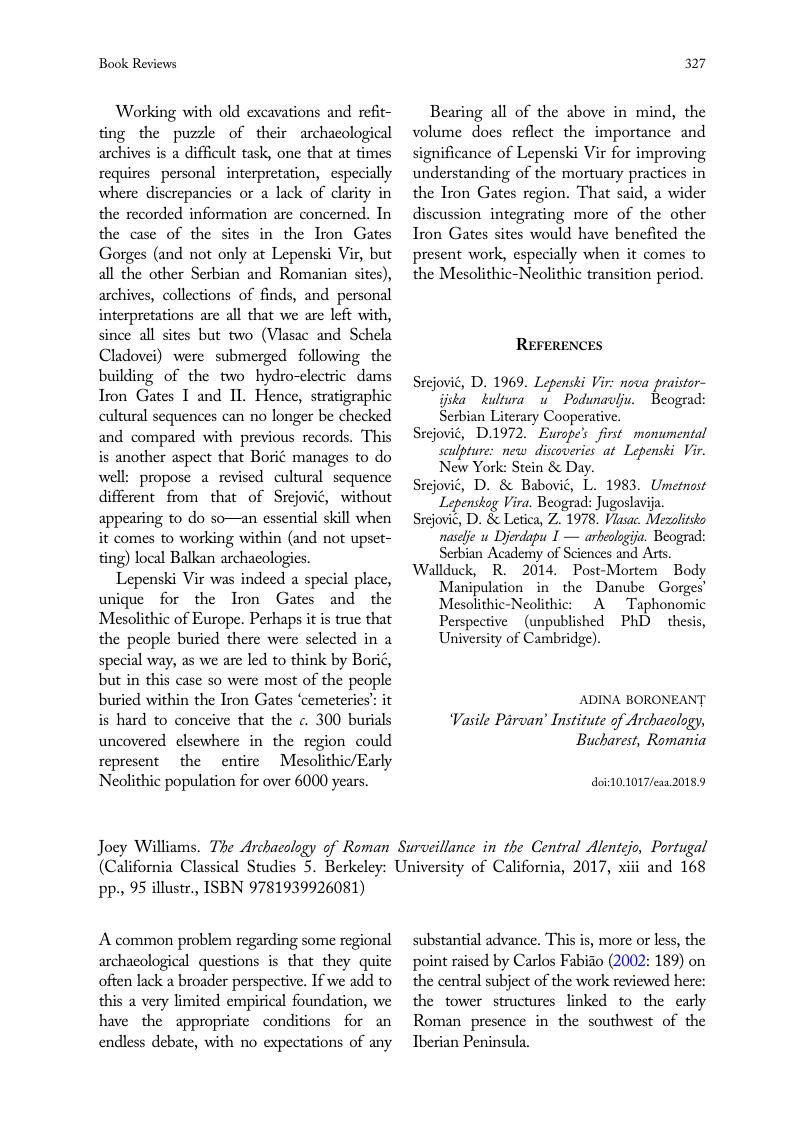No CrossRef data available.
Article contents
Joey Williams. The Archaeology of Roman Surveillance in the Central Alentejo, Portugal (California Classical Studies 5. Berkeley: University of California, 2017, xiii and 168 pp., 95 illustr., ISBN 9781939926081)
Review products
Joey Williams. The Archaeology of Roman Surveillance in the Central Alentejo, Portugal (California Classical Studies 5. Berkeley: University of California, 2017, xiii and 168 pp., 95 illustr., ISBN 9781939926081)
Published online by Cambridge University Press: 23 April 2018
Abstract
An abstract is not available for this content so a preview has been provided. Please use the Get access link above for information on how to access this content.

- Type
- Book Review
- Information
- Copyright
- Copyright © European Association of Archaeologists 2018
References
De Reu, J., Bourgeois, J., De Smedt, P., Zwertvaegher, A., Antrop, M., Bats, M., De Maeyer, P., Finke, P., Van Meirvenne, M., Verniers, J. & Cromb, P. 2011. Measuring the Relative Topographic Position of Archaeological Sites in the Landscape: A Case Study on the Bronze Age Barrows in Northwest Belgium. Journal of Archaeological Science, 38: 3435‒46. doi: https://doi.org/10.1016/j.jas.2011.08.005Google Scholar
Fabião, C. 2002. Os chamados castella do sudoeste: arquitectura, cronología e funções. Archivo Español de Arqueología, 75:177‒93.Google Scholar
Fairén Jiménez, S. 2007. British Neolithic Rock Art in Its Landscape. Journal of Field Archaeology, 32: 283‒95. doi: https://doi.org/10.1179/009346907791071584Google Scholar
Kvamme, K. 1992. Terrain Form Analysis of Archaeological Location through Geographic Information Systems. In: Lock, G. & Moffet, J., eds. CAA91: Computer Applications and Quantitative Methods in Archaeology 1991 (BAR International Series S577). Oxford: Tempus Reparatum, pp. 127‒36.Google Scholar
Mataloto, R. 2002. Fortins e recintos-torre do Alto Alentejo: antecâmara da ‘romanização’ dos campos. Revista Portuguesa de Arqueologia, 5: 161‒220.Google Scholar
Moret, P. 1990. Fortins, ‘Tours d´Hannibal’ et fermes fortifiées. Melanges de la Casa de Velázquez, 26(1): 5‒43.Google Scholar
Moret, P. 2016. Les tours isolées de l'Hispanie romaine : postes militaires ou maisons fortes? In: Frederiksen, R., Müth, S., Schneider, P.I. & Schnelle, M., eds. Focus on Fortifications: New Research on Fortifications in the Ancient Mediterranean and the Near East (Monographs of the Danish Institute at Athens 18). Oxford: Oxbow Books, pp. 456‒68.Google Scholar
Sala Sellés, F. & Moratalla Jávega, J. eds. 2014. Las guerras civiles romanas en Hispania: una revisión histórica desde la Contestania. Alicante: Diputación de Alicante & Universidad de Alicante.Google Scholar
Stockhammer, P.W. ed. 2012. Conceptualizing Cultural Hybridization: A Transdisciplinary Approach. Heidelberg, Dordrecht, London & New York: Springer.Google Scholar
Woolf, G. 2004. Romanization 2.0 and Its Alternatives. Archaeological Dialogues, 21: 45‒50. doi: https://doi.org/10.1017/S1380203814000087Google Scholar


